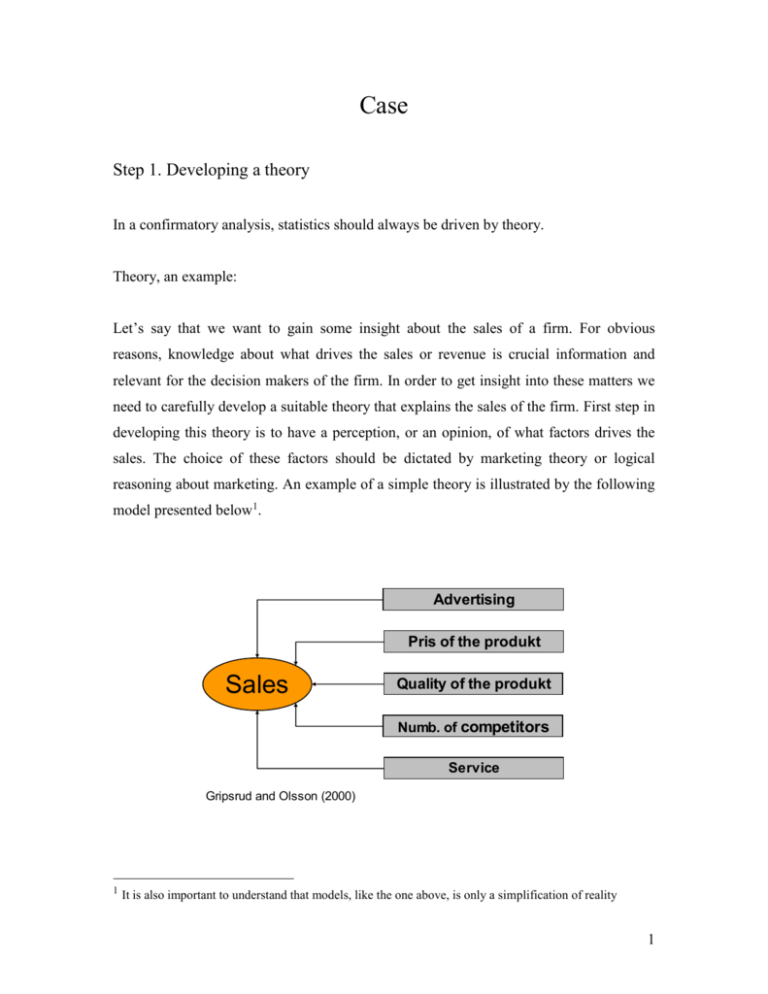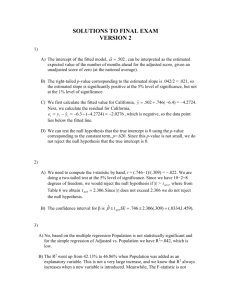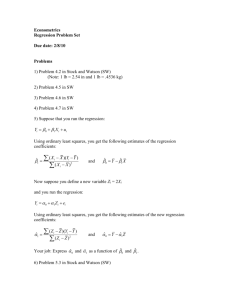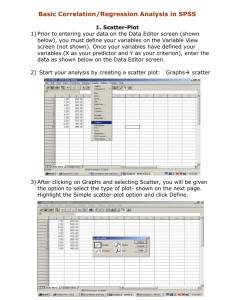Case statistics
advertisement

Case Step 1. Developing a theory In a confirmatory analysis, statistics should always be driven by theory. Theory, an example: Let’s say that we want to gain some insight about the sales of a firm. For obvious reasons, knowledge about what drives the sales or revenue is crucial information and relevant for the decision makers of the firm. In order to get insight into these matters we need to carefully develop a suitable theory that explains the sales of the firm. First step in developing this theory is to have a perception, or an opinion, of what factors drives the sales. The choice of these factors should be dictated by marketing theory or logical reasoning about marketing. An example of a simple theory is illustrated by the following model presented below1. Advertising Pris of the produkt Sales Quality of the produkt Numb. of competitors Service Gripsrud and Olsson (2000) 1 It is also important to understand that models, like the one above, is only a simplification of reality 1 It is quite reasonable to assume that factors, such as advertising, price of the product, quality of the product, number of competitors and service, would have an impact on the sales2. In this case these factors seem to be obvious choices. Even though the developed theory appears to be quite plausible and reasonable, we would still want to confirm our theory by some objective measurement. By objective measurement we often mean statistical analysis. A well known and often used statistical tool is regression analysis, which is one of the most applied tools in research. A natural extension, and very important part, of the developing stage is to form, or specify, a priori “before hand” opinion about how the different factors influence the variable of interest, which in our specific case is sales. Using simple logic, one might expect that advertising, quality, and service would have a positive impact on the sales, while price and the number of competitors would have a negative impact. Step 2. Model formulation Before we are able to perform any statistical test, we need to formulate our theory mathematically. A very general formulation of the model is of the form Sales f ( advertising, price of the product, quality of the product, number of competitors, service) This expression is not particularly informative and since we are using linear regression as our primary tool, the model is expressed as the following linear relationship Sales 0 1 advertising 2 price of the product + 3 quality of the product + 4 number of competitors + 5 service, 2 Note that, in practice, some of these factors could be very difficult to measure. 2 where sales is the dependent variable (LHS of the equation) and advertising, price of the product, quality of the product, number of competitors and service are independent variables (RHS of the equation)3. 0 is referred to as the constant term, while 1 , 2 ,....., 5 is referred to as regression coefficients or regression parameters. By definition, models are only simplifications of reality, and it is not possible to account for all factors or variables that may have an impact on the dependent variable. For that reason, we need to include a stochastic error term, denoted by epsilon, into the equation. Sales 0 1 advertising 2 price of the product + 3 quality of the product + 4 number of competitors + 5 service + The RHS of the equation is comprised of two parts. The first six terms is the deterministic (explained) part, while represents the stochastic (unexplained) part. Interpretation of the model The constant term 0 gives the value of the dependent variable when all the independent variables are zero. Notice, that in most cases it can be difficult to give a meaningful interpretation of the constant term. Unless one has a strong theoretical justification, the constant term should always remain in the regression. If the constant term is removed from the regression, critical assumptions underlying the OLS estimation technique might be seriously violated, and the consequence could be that the statistical results become highly unreliable. The regression coefficients ( 1 , 2 ,....., 5 ) measures how sensitive the dependent variable is to a unit change in the associated independent variable. In other words, if the absolute magnitude of is large, only a small change in the independent variable will have a significant impact on the dependent variable. 3 Independent variables are often referred to as predictor variables or explanatory variables. 3 Step 3. Model testing An example: In the following, an example of how to implement a simplified version of the model will be given. The somewhat simpler model has this form Sales 0 1 advertising + 2 quality + In this case Sales and advertising is measured in 1000 nkr and quality is an continuous variable running from 0 to 10, where 0 indicates low product quality and 10 indicates high product quality. Before running the regression it is always advisable to perform a correlation analysis. The correlation analysis will provide us with valuable information about the degree of covariation between the variables. Correlations ADVERTIS SALES QUALITY Pears on Correlation Sig. (2-tailed) N Pears on Correlation Sig. (2-tailed) N Pears on Correlation Sig. (2-tailed) N ADVERTIS 1 , 19 ,664** ,002 19 ,173 ,480 19 SALES QUALITY ,664** ,173 ,002 ,480 19 19 1 ,252 , ,299 19 19 ,252 1 ,299 , 19 19 **. Correlation is s ignificant at the 0.01 level (2-tailed). We clearly see that the relationship between advertising and Sales seems quite strong. The correlation between these two variables equals 0.664. This number indicates that there is a significant relationship between these two variables. The correlation between the independent variables, advertising and quality, is relatively weak (0.0173). A strong 4 correlation between the independent variables could be an indication of problems with multicollinarity in the data. Additionally, the correlation between quality and Sales is not particularly strong either (0.299). At this point we have established that there is a positive relationship between the dependent variable and the independent variables. These observations are in line with the above suggested theory. Running this regression model in SPSS, we get the following results Model Summary Model 1 R R Square ,678 a ,460 Adjus ted R Square ,392 Std. Error of the Es timate 205,75668 a. Predictors : (Constant), QUALITY, ADVERTIS ANOVAb Model 1 Regress ion Res idual Total Sum of Squares 576141,8 677373,0 1253515 df Mean Square 288070,887 42335,810 2 16 18 F 6,804 Sig. ,007 a t 7,501 3,425 ,757 Sig. ,000 ,003 ,460 a. Predictors : (Constant), QUALITY, ADVERTIS b. Dependent Variable: SALES Coefficientsa Model 1 (Cons tant) ADVERTIS QUALITY Uns tandardized Coefficients B Std. Error 1074,899 143,300 19,711 5,754 11,464 15,135 Standardized Coefficients Beta ,639 ,141 a. Dependent Variable: SALES The statistical results should always be evaluated and discussed in light of theory and the priori opinion formed in the step 1. (design stage). As can be seen from the tables, the coefficient associated with advertising, 1 , equals 19.711. Note that the sign of this coefficient is positive, meaning that an increase in advertising result in an increase in sales. The interpretation is that, if we increase the level of marketing by 1000 nkr, sales 5 increases by 19.711 nkr. The same overall pattern and conclusions applies for the variable quality. These observations are perfectly in line with our theory and priori opinion. Goodness of fit statistics It is desirable to have measure of how well the regression model actually fits the data. More specifically, it is desirable to have an answer to the question ‘how well does the model containing the independent variables that was proposed actually explain the variation in the dependent variable?’ We will use R 2 as a measure of how close the fitted regression line is to all of the data points taken together. R 2 runs from 0 – 1, where 0 indicates independence (zero correlation) between the dependent variable and the independent variable(s), while a value of 1 indicates perfect fit. Returning to the example, if we take a look at the model summery we see that the adjusted value of R 2 equals 0.3924. This simply means that the two independent variables in our model explain about 40% of the variation in Sales. Even though this value might seem low, it is quite reasonable. Hypothesis testing A crucial element of statistical analysis is hypothesis testing. More specifically we want to test the individual regression coefficients as well as the entire model. F-test The F-test is used for testing multiple hypotheses H 0 : 1 2 ....... k 0 H A : at least one i 0 2 Note that we always use the adjusted value of R when the model contains more than one independent variable in the model. 4 6 It can be seen from the alternative hypothesis ( H A ) that if only one regression coefficient significantly deviates from zero, we reject the joint hypothesis ( H 0 ) , stating that all the regression coefficients equals zero and statistically conclude that the model is adequate. For our specific model we find that the p-value is less than 0.05 (0.007), which indicates that at least one of the regression coefficients is significantly different from zero. t-test The t-test is used to test single hypothesis, i.e. hypothesis involving only one coefficient. Normally we want to test the following hypothesis5 H0 : 0 HA : 0 In order to test this hypothesis we need to calculate the t-statistic. The formula for the tstatistic is t SE ( ) , where SE ( ) is the standard deviation, which is a measure of the uncertainty associated with the -value. Given a significance level of 5%, the general rule is; if the absolute value of the t-statistic is equal to or larger than 1.96 (gives a p-value < 0.05), we reject the H 0 -hypothesis stating that the independent variable, associated with , has no impact on the dependent variable. We then adopt the alternative hypothesis ( H A ), stating that the independent variable has a significant impact on the dependent variable. On the other 5 It could, however, be the case that our theory predicts that should have is a particular value. 7 hand, if the absolute value of the t-statistic is less than 1.96 (gives a p-value > 0.05), we keep the H 0 -hypothesis. From the table, containing the coefficients, we see that the t-statistic associated with advertising equals 3.425. Since this value is significantly larger than 1.96, the p-value is less than 0.05 (0.003). This means that we can statistically conclude that advertising has a significant impact on sales. This confirms and increases the validity of our theory. The tstatistic can easily be calculated by hand from the information provided in the output results t-statistic 19.711 3.425 5.754 Note however that the t-statistic associated with the variable quality is less 1.96 and the p-value is larger than 0.05 (0.46). By these statistics we cannot conclude that the -value is significantly different from zero. This conclusion is however in conflict with our theory and it might be necessary to go back to step 1 and re-evaluate our theory. Another explanation for this particular result could be that the variable, quality, fails to measure the actual quality, then we have validity problem. Given the evaluation so far, it might be a good idea to run a regression without the variable quality. Model Summary Model 1 R R Square ,664 a ,440 Adjus ted R Square ,407 Std. Error of the Es timate 203,16103 a. Predictors : (Constant), ADVERTIS 8 ANOVAb Model 1 Regress ion Res idual Total Sum of Squares 551849,9 701664,9 1253515 df 1 17 18 Mean Square 551849,853 41274,405 F 13,370 Sig. ,002 a a. Predictors : (Constant), ADVERTIS b. Dependent Variable: SALES Coefficientsa Model 1 (Cons tant) ADVERTIS Uns tandardized Coefficients B Std. Error 1100,651 137,452 20,464 5,597 Standardized Coefficients Beta ,664 t 8,008 3,657 Sig. ,000 ,002 a. Dependent Variable: SALES Even though we ha removed one variable from the analysis, the regression coefficient and the t-statistic did not change much. Additionally, the value of R 2 is now 0.44, which is somewhat higher than before. Notice that, since we are running a regression with a single independent variable we do not use the adjusted value of R 2 as we did before. These observations are a clear indication that the variable quality was an irrelevant variable. The conclusion is that this model seems to be quite suitable and the best so far. It is often the case that a simpler model is preferable, unless the results or theory suggests otherwise. 9







